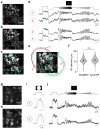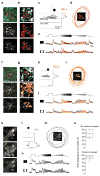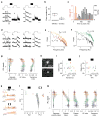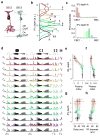Inhibition decorrelates visual feature representations in the inner retina
- PMID: 28178238
- PMCID: PMC5325673
- DOI: 10.1038/nature21394
Inhibition decorrelates visual feature representations in the inner retina
Abstract
The retina extracts visual features for transmission to the brain. Different types of bipolar cell split the photoreceptor input into parallel channels and provide the excitatory drive for downstream visual circuits. Mouse bipolar cell types have been described at great anatomical and genetic detail, but a similarly deep understanding of their functional diversity is lacking. Here, by imaging light-driven glutamate release from more than 13,000 bipolar cell axon terminals in the intact retina, we show that bipolar cell functional diversity is generated by the interplay of dendritic excitatory inputs and axonal inhibitory inputs. The resulting centre and surround components of bipolar cell receptive fields interact to decorrelate bipolar cell output in the spatial and temporal domains. Our findings highlight the importance of inhibitory circuits in generating functionally diverse excitatory pathways and suggest that decorrelation of parallel visual pathways begins as early as the second synapse of the mouse visual system.
Conflict of interest statement
The authors declare no competing financial interests. Readers are welcome to comment on the online version of the paper.
Figures















Comment in
-
Systems neuroscience: Diversity in sight.Nature. 2017 Feb 23;542(7642):418-419. doi: 10.1038/nature21498. Epub 2017 Feb 8. Nature. 2017. PMID: 28178231 No abstract available.
Similar articles
-
The Synaptic and Morphological Basis of Orientation Selectivity in a Polyaxonal Amacrine Cell of the Rabbit Retina.J Neurosci. 2015 Sep 30;35(39):13336-50. doi: 10.1523/JNEUROSCI.1712-15.2015. J Neurosci. 2015. PMID: 26424882 Free PMC article.
-
Cholinergic excitation complements glutamate in coding visual information in retinal ganglion cells.J Physiol. 2018 Aug;596(16):3709-3724. doi: 10.1113/JP275073. Epub 2018 Jun 21. J Physiol. 2018. PMID: 29758086 Free PMC article.
-
Quantifying the effect of light activated outer and inner retinal inhibitory pathways on glutamate release from mixed bipolar cells.Synapse. 2018 May;72(5):e22028. doi: 10.1002/syn.22028. Epub 2018 Feb 2. Synapse. 2018. PMID: 29360185
-
Amacrine cell-mediated input to bipolar cells: variations on a common mechanistic theme.Vis Neurosci. 2012 Jan;29(1):41-9. doi: 10.1017/S0952523811000241. Vis Neurosci. 2012. PMID: 22310371 Review.
-
Synaptic release at mammalian bipolar cell terminals.Vis Neurosci. 2011 Jan;28(1):109-19. doi: 10.1017/S0952523810000453. Vis Neurosci. 2011. PMID: 21272392 Free PMC article. Review.
Cited by
-
Neural circuits in the mouse retina support color vision in the upper visual field.Nat Commun. 2020 Jul 13;11(1):3481. doi: 10.1038/s41467-020-17113-8. Nat Commun. 2020. PMID: 32661226 Free PMC article.
-
Bayesian hypothesis testing and experimental design for two-photon imaging data.PLoS Comput Biol. 2019 Aug 2;15(8):e1007205. doi: 10.1371/journal.pcbi.1007205. eCollection 2019 Aug. PLoS Comput Biol. 2019. PMID: 31374071 Free PMC article.
-
Ancient origin of the rod bipolar cell pathway in the vertebrate retina.Res Sq [Preprint]. 2023 Oct 10:rs.3.rs-3411693. doi: 10.21203/rs.3.rs-3411693/v1. Res Sq. 2023. Update in: Nat Ecol Evol. 2024 Jun;8(6):1165-1179. doi: 10.1038/s41559-024-02404-w. PMID: 37886445 Free PMC article. Updated. Preprint.
-
Bipolar Cell Type-Specific Expression and Conductance of Alpha-7 Nicotinic Acetylcholine Receptors in the Mouse Retina.Invest Ophthalmol Vis Sci. 2019 Apr 1;60(5):1353-1361. doi: 10.1167/iovs.18-25753. Invest Ophthalmol Vis Sci. 2019. PMID: 30934054 Free PMC article.
-
Zebrafish Retinal Ganglion Cells Asymmetrically Encode Spectral and Temporal Information across Visual Space.Curr Biol. 2020 Aug 3;30(15):2927-2942.e7. doi: 10.1016/j.cub.2020.05.055. Epub 2020 Jun 11. Curr Biol. 2020. PMID: 32531283 Free PMC article.
References
-
- Sanes JR, Masland RH. The Types of Retinal Ganglion Cells: Current Status and Implications for Neuronal Classification. Annu Rev Neurosci. 2015;38:221–46. - PubMed
-
- Euler T, Haverkamp S, Schubert T, Baden T. Retinal bipolar cells: elementary building blocks of vision. Nat Rev Neurosci. 2014;15:507–19. - PubMed
-
- Helmstaedter M, et al. Connectomic reconstruction of the inner plexiform layer in the mouse retina. Nature. 2013;500:168–74. - PubMed
Publication types
MeSH terms
Substances
Grants and funding
LinkOut - more resources
Full Text Sources
Other Literature Sources
Molecular Biology Databases

